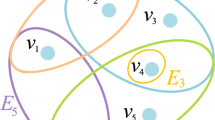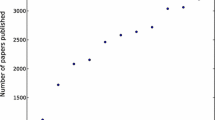Abstract
We discuss microscopic mechanisms of complex network growth, with the special emphasis of how these mechanisms can be evaluated from the measurements on real networks. As an example we consider the network of citations to scientific papers. Contrary to common belief that its growth is determined by the linear preferential attachment, our microscopic measurements show that it is driven by the nonlinear autocatalytic growth. This invalidates the scale-free hypothesis for the citation network. The nonlinearity is responsible for a dramatic dynamical phase transition: while the citation lifetime of majority of papers is 6–10 years, the highly-cited papers have practically infinite lifetime.









Similar content being viewed by others
Notes
Consider a cohort of papers published in the same year. After a couple of years, when the general interest to this cohort already decayed, the annual number of citations gained by previously uncited papers is either 0 or 1. Therefore, the mean annual number of additional citations gained by previously uncited papers is \(\overline{\Delta k_{i}}\approx\Delta N_{0}/N_{0}\) where N 0 is the number of uncited papers and ΔN 0=N 0(t)−N 0(t+1) is the number of uncited papers that got their first citation during recent year t+1. If the total number of papers in the dataset is N, then \(\overline{\Delta k_{i}}\approx\Delta P_{0}/P_{0}\) where P 0=N 0/N is the fraction of uncited papers.
References
de Solla Price, D.: A general theory of bibliometric and other cumulative advantage processes. J. Am. Soc. Inf. Sci. 27, 292 (1976)
Albert, R., Barabasi, A.L.: Statistical mechanics of complex networks. Rev. Mod. Phys. 74, 47 (2002)
Newman, M.E.J.: The structure and function of complex networks. SIAM Rev. 45, 167 (2003)
Redner, S.: Citation statistics from 110 years of physical review. Phys. Today 58, 49 (2005)
Stringer, M.J., Sales-Pardo, M., Amaral, L.A.N.: Effectiveness of journal ranking schemes as a tool for locating information. PLoS ONE 3, e1683 (2008)
Radicchi, F., Fortunato, S., Castellano, C.: Universality of citation distributions: toward an objective measure of scientific impact. Proc. Natl. Acad. Sci. USA 105, 17268 (2008)
Petersen, A.M., Wang, F., Stanley, H.E.: Methods for measuring the citations and productivity of scientists across time and discipline. Phys. Rev. E 81, 036114 (2010)
Golosovsky, M., Solomon, S.: Runaway events dominate the heavy tail of citation distributions. Eur. Phys. J. 205, 303 (2012)
Krapivsky, P.L., Redner, S.: Organization of growing random networks. Phys. Rev. E 63, 066123 (2001)
Dorogovtsev, S.N., Mendes, J.F.F.: Evolution of networks. Adv. Phys. 51, 1079 (2002)
Malcai, O., Biham, O., Solomon, S.: Power-law distributions and Lévy-stable intermittent fluctuations in stochastic systems of many autocatalytic elements. Phys. Rev. E 60, 1299 (1998)
Blank, A., Solomon, S.: Power laws in cities population, financial markets and Internet sites (scaling in systems with a variable number of components). Physica A 287, 279 (2000)
Jeong, H., Neda, Z., Barabasi, A.L.: Measuring preferential attachment in evolving networks. Europhys. Lett. 61, 567 (2003)
Eom, Y.-H., Jeon, C., Jeong, H., Kahng, B.: Evolution of weighted scale-free networks in empirical data. Phys. Rev. E 77, 056105 (2008)
Eom, Y.-H., Fortunato, S.: Characterizing and modeling citation dynamics. PLoS ONE 6, e24926 (2011)
Valverde, S., Solé, R.V., Bedau, M.A., Packard, N.: Topology and evolution of technology innovation networks. Phys. Rev. E 76, 056118 (2007)
Csardi, G., Strandburg, K.J., Zalanyi, L., Tobochnik, J., Erdi, P.: Modeling innovation by a kinetic description of the patent citation system. Physica A 374, 783 (2007)
Wang, M., Yu, G., Yu, D.: Measuring the preferential attachment mechanism in citation networks. Physica A 387, 4692 (2008)
Tomassini, M., Luthi, L.: Empirical analysis of the evolution of a scientific collaboration network. Physica A 385, 750 (2007)
Newman, M.E.J.: Clustering and preferential attachment in growing networks. Phys. Rev. E 64, 025102 (2001)
Capocci, A., Servedio, V.D.P., Colaiori, F., Buriol, L.S., Donato, D., Leonardi, S., Caldarelli, G.: Preferential attachment in the growth of social networks: the Internet encyclopedia Wikipedia. Phys. Rev. E 74, 036116 (2006)
Herdagdelen, A., Aygun, E., Bingol, H.: A formal treatment of generalized preferential attachment and its empirical validation. Europhys. Lett. 78, 60007 (2007)
Eisenberg, E., Levanon, E.Y.: Preferential attachment in the protein network evolution. Phys. Rev. Lett. 91, 138701 (2003)
Sheridan, P., Yagahara, Y., Shimodaira, H.: Measuring preferential attachment in growing networks with missing-timelines using Markov chain Monte Carlo. Physica A 391, 5031 (2012)
Goffman, W., Newill, V.A.: Generalization of epidemic theory: an application to the transmission of ideas. Nature 4953, 225 (1964)
Bettencourt, L.M.A., Cintron-Arias, A., Kaiser, D.I., Castillo-Chavez, C.: The power of a good idea: quantitative modeling of the spread of ideas from epidemiological models. Physica A 364, 513 (2006)
Krapivsky, P.L., Redner, S.: Network growth by copying. Phys. Rev. E 71, 036118 (2005)
Simkin, M.V., Roychowdhury, V.P.: A mathematical theory of citing. J. Am. Soc. Inf. Sci. Technol. 58, 1661 (2007)
Golosovsky, M., Solomon, S.: Stochastic dynamical model of a growing citation network based on a self-exciting point process. Phys. Rev. Lett. 109, 098701 (2012)
Acknowledgements
We are grateful to Filippo Radicchi, Alexander Petersen, Oleg Yordanov, and Andrea Scharnhorst for fruitful discussions.
Author information
Authors and Affiliations
Corresponding author
Rights and permissions
About this article
Cite this article
Golosovsky, M., Solomon, S. The Transition Towards Immortality: Non-linear Autocatalytic Growth of Citations to Scientific Papers. J Stat Phys 151, 340–354 (2013). https://doi.org/10.1007/s10955-013-0714-z
Received:
Accepted:
Published:
Issue Date:
DOI: https://doi.org/10.1007/s10955-013-0714-z




